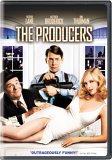The Producers has taken an almost cinematic storyline of its own. In 1967 Mel Brooks filmed this tale with one of his mainstays, Gene Wilder. The film was a modest success. It was as a Broadway production that this material reached a wide audience. The play has been a hit for decades now. It only seems inevitable that a new film would surface. This 2005 version of the story is closer to the stage production than the original film. There are quite a few more musical numbers, and that’s essentially where this film goes wrong. What works as a stage production will not necessarily work as a feature film. Everything about this movie is over the top except its heart. Nathan Lane and Matthew Broderick reprise their stage roles of Bialystock and Bloom with different results. Broderick appears to have gotten so comfortable with the role that he seems to be sleepwalking through it for the film. Lane, on the other hand, carries the film on his very broad shoulders. His mannerisms recall Lou Costello. His voice is actually quite remarkable and is the highlight of any of the numbers he’s in. The addition of Uma Thurman as a Swedish bombshell feels forced on so many levels, from her horrible accent to her mismatched chemistry with Broderick’s Bloom.
The 40 year old story still has potential that falls short in this film. Bialystock and Bloom are attempting to produce a Broadway flop. Why? Because if you can pull in enough investor cash and close after one day, you can walk away with millions of dollars. They set out to find the worst play and hire the bottom of the heap. What can go wrong? How can a pro-Nazi production called “Springtime For Hitler” not crash and burn on opening day? If it’s a Mel Brooks written plot, you can count on everything going wrong, and of course, the play becomes a hit. The film picks up a bit when the “Springtime For Hitler” show is finally underway. Still, the film is overlong at 2 hours and 15 minutes. Some of the numbers drag on pointlessly. The film was intended to bring the Broadway experience to the film’s audience, but it fails at almost every turn.
Video
The Producers is presented in an unusual 2.40:1 aspect ratio. The look and feel of this film is very much reminiscent of the 70’s and 80’s down to the film stock. Colors are often rich but never really bright. The maroon of Bialystock’s leisure jacket is a sweet example of the color reproduction. Contrast is above average. Black levels are likely little more than average. There is evidence of compression artifact, most noticeably in the black levels. The print is clean and grain is minimal.
Audio
The Dolby Digital 5.1 track fails to impress, particularly when the musical numbers are such a huge part of the film experience. While the staging of the film goes to great lengths to create a larger than life atmosphere during the musical numbers, the sound mix can only be described as small. There’s no use of the available sound field or 5.1 separation. There’s certainly no bottom end to speak of. It’s actually quite frustrating to see big and hear so small. I felt like I was watching these numbers from a closed window. I could see the scope, but the sound was muted by the glass. A shame, really. Many of the numbers offered extraordinary potential.
There is a rather dull audio commentary offered by director and choreographer Susan Stroman. The track sounds very much like a college lecture. She’s obviously working from detailed notes if not a predrafted script. There’s plenty of dead air.
Special Features
There are 10 deleted scenes. This was already a long film, and none of the scenes shown here add much to the experience. The first was obviously cut for language and the sake of a PG-13 rating.
A whopping 15 minutes of outtakes is often funnier than the actual film. Still, 15 minutes? Another example of how everything about this release is taken too far.
In “Analysis of a Scene” you’ll learn everything you always wanted to know and much more about the “I Wanna Be A Producer” number sung by Broderick in the film. Mel Brooks and Stroman weigh in throughout. You’ll see the rehearsals, staging, costuming, set design, and choreography in a 15 minute examination of the number. Again, too long..
Final Thoughts
In some ways this film pays homage to the MGM musicals of the early days. The sets are lavish and the musical numbers extensive. Still, it never quite connects. Watching the film I can see why it was such a stage hit. It just doesn’t translate well enough. Perhaps a better template would have been the original Brooks film. The PG-13 rating is a bit mild. There are moments of toilet humor and sexual innuendo that are not likely age appropriate. This is definitely not a family film. Another mistake was likely having the director also choreograph the numbers. She spent too much effort drawing attention to the choreography, which should have spoken for itself. In short there just weren’t enough laughs to make this any more than a possible renter. Check it out some rainy Saturday night when the kids are in bed. It’s not exactly “the worst show in town.”
Screenshots








